
![]() DESIGNING HIGH QUALITY OUTDOOR HABITATS FOR TORTOISES
DESIGNING HIGH QUALITY OUTDOOR HABITATS FOR TORTOISES
By A. C. and Nadine Highfield.
An excellent outdoor pen for Desert tortoises. This pen provides all the elements required for a long, healthy and happy life. There is enough space, it is well planted, the substrate is well drained and dry, the perimeters are secure and there is safe, dry overnight housing.
Where possible, outdoor housing will provide the best quality of life to a captive tortoise. Very few tortoises are suitable for keeping as exclusively indoor pets. The closer your own location is to the natural habitat of the species you keep, the easier it is to provide high quality outdoor housing.
If you live in a region with high ambient humidity and high temperatures, you may do very well with some of the tropical species. If you live in an area with very low humidity or low temperatures you may find keeping tropical forest species outdoors impossible. In such cases, you will certainly have to rely upon a combination of indoor and outdoor housing for much of the year. If you live in a region with cool, short summers and long, cold winters you are going to find keeping tortoises much more work (and cost) intensive than keepers who live in warmer environments.
Tropical forest habitats need high ambient air humidity, moist substrates, lower lighting levels and stable temperatures. They can be quite a challenge to construct and maintain.
All pens need to be secure against two eventualities: the tortoises inside getting out, and potentially lethal predators getting in. The list of predators that can attack and kill tortoises is quite long, and includes rats, dogs, raccoons, badgers, hedgehogs and even large birds. In some localities, even ants can pose a significant threat. The Tortoise Trust receives several calls a year from people who have had their tortoise attacked, and often killed, by their family’s previously well-behaved pet dog.
Juveniles and hatchlings are especially vulnerable to attacks by predators. Ensure all such pens are adequately protected, day and night.
The outer perimeters of all pens need to be of adequate height, at least twice as high as the largest tortoise is long. Corners need to be adequately secured, as many species are excellent climbers. Other species are adept at digging and burrowing. Burying a wire mesh barrier beneath ground level as part of the perimeter is highly advisable in such cases.
Large tortoises, such as these Leopards (Geochelone pardalis) demand incredibly strong barriers if escape is to be prevented!.
Despite their ‘slow’ reputation, then, tortoises are really very agile creatures, as the number of tortoises reported as escaped each year to the Tortoise Trust testifies!
Tortoise enclosure design
Flat pens on a grassy lawn are not an adequate environment for any tortoise.
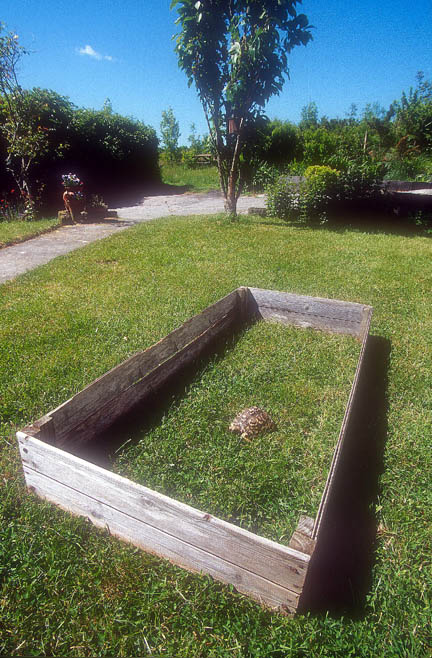
How NOT to do it. Flat, featureless, not escape proof, open to predators, incorrect substrate, no retreats or hiding places.
Non-tropical tortoises need very well drained substrates and pens should contain a variety of slopes, rocks, open basking areas, shady areas, and good provision of edible vegetation.
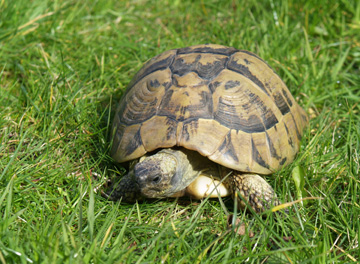
Tortoises kept on damp grass can develop severe shell infections and respiratory disease. It is NOT a suitable substrate for Mediterranean or any other semi-arid habitat tortoise.
Abscess under the shell caused by using a substrate that is far too damp.
This is an incredibly common fault in pen design.
Examples of the correct type of outdoor pen for Mediterranean tortoises featuring well-drained substrates with slopes, edible vegetation and supplementary basking facilities. This is the type of thing to aim for when constructing outdoor habitats! Compare these to actual wild habitats.
A predator-proof overnight or poor-weather shelter should also be available. One simple design resembles a small cloche or gardener’s cucumber frame. Based on a strong, rot-proof wooden frame and featuring a tough polycarbonate transparent roof, this type of unit can make a major difference to the overall health of any Mediterranean tortoise. The tortoise can enter and leave this unit at will, and it will quickly learn to use it in its daily thermoregulation cycle. In effect, this creates a mini-greenhouse, and temperatures within such a unit can easily be up to 10 Celsius warmer than temperatures outside. This can make a huge difference to feeding and overall health. No artificial heat is needed, as even on wet and overcast days, this unit will be dry and warm.
A small 'cloche' type shelter suitable for juveniles.
Pens on dead flat surfaces are not attractive to tortoises as they much prefer a sloped or undulating topography. If a tortoise falls upon its back on a dead flat and smooth surface, it may have difficulty righting itself, whereas on a sloped, rough surface with vegetation cover they can usually ‘flip’ themselves over rapidly.
It is absolutely vital that Mediterranean or other semi-arid habitat tortoises are maintained on well-drained substrates. Damp, saturated clay-type substrates will contribute to an increased incidence of shell infections, especially on the plastron (underside) and also to increased likelihood of serious respiratory conditions. Aim for a mix of loose, sandy-type soils for all Testudo species.
An outdoor pen for Egyptian tortoises (Testudo kleinmanni) closely based upon their natural habitat (below)
Many people greatly underestimate the effect that the correct choice of substrate has on the overall health of tortoises. In many cases, it can make the difference between long-term survival and a life plagued by infections.
If you really do have a very heavy, damp soil in your tortoise keeping area some major effort is required to overcome this. We have previously experimented with digging out this type of soil and replacing it with lighter, sandy material but this was not entirely successful. It still became damp and saturated. A more effective solution is to raise the level of the pen. This is very similar to the gardener's 'raised bed' concept. Shown below on a small scale, we have here a wooden 'sand pit' obtained from a toy store converted into a dry, well drained habitat for juvenile Testudo hermanni (vegetation, predator protection mesh and hides have been removed for illustration purposes).
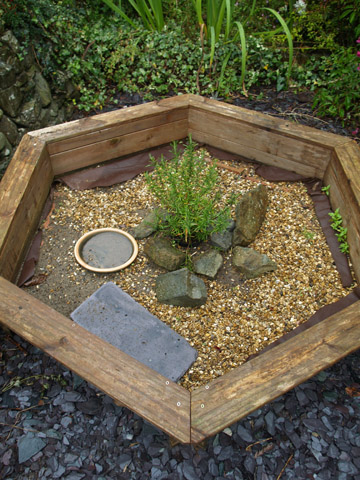
This was made by first laying down a slate chip screed on top of landscape fabric over the damp, heavy substrate. Then, the pen was placed in position. A secondary layer of landscape fabric (visible as the brown material in this photo) was layered over the screed inside the unit. It was then filled to a depth of 100mm (4 inches) with sand, light soil, and grit. Plants can be added as can hides and a predator screen. The landscape fabric not only retains the substrate and helps with drainage, but it is also a good security measure as tortoises cannot easily dig through it. This is a small, juvenile pen - but this same concept can be extended to almost any size. This type of pen really works - we have tested them for three years. They provide a tortoise friendly dry substrate even on heavy clay soils in rainy areas. Use your imagination and see what you can do using readily available items and supplies.
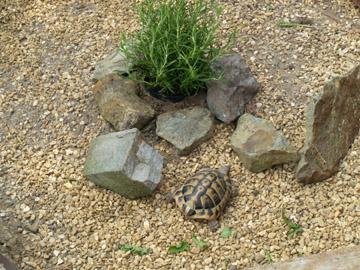
Whatever substrate you use do make sure that it does provide the correct environment for the species. Tropical tortoises or box turtles need completely different conditions from arid habitat tortoises.
Tortoises often bury deep down in their substrate so it is vital that it provides both the correct microclimate and is safe. It is usually reasonable to assume that the NATURAL HABITAT of the species is the best guide to the substrate required!
A well-planted pen of adequate size can also be largely self-supporting in terms of food provision, permitting grazing at will on a high fibre, healthy diet of mixed flowers, herbs and miscellaneous edible “weeds”.

Both of these pens were planted with edible wild flower mixes suitable for Mediterranean tortoises. Within 2 years the tortoises within them were 100% self-sufficient in terms of feeding and needed no supplementary food whatever. You do need large, low density pens to achieve this, however. Note also the slopes and very well drained substrate. Dry houses for overnight use were included, as were cold-frame and cloche type units. We tested these pens for a period of 10 years at the Tortoise Trust and found them to be by far the best way to maintain Testudo species out of doors in the UK (additional polytunnel, greenhouse and indoor facilities were also available).
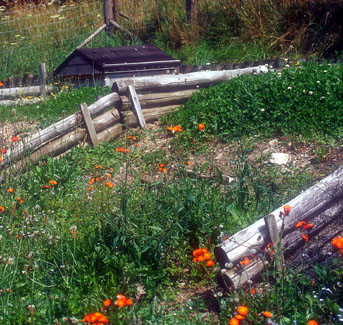
Plants also provide hiding places and shade. Our own pens have been designed to meet both needs. Additional shade is provided by use of half-buried hollowed-out logs, and by plastic pots or buckets cut in half and partially buried. These allow the tortoises to retreat to a stable microclimate in case of very hot or very cold weather, just as they would retreat to their scrapes or burrows in the wild.
By providing mounds and areas suitable for digging, tortoises will excavate their own scrapes and burrows. They cannot do this easily on completely flat surfaces.
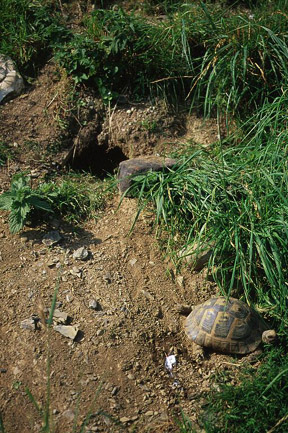
The outdoor requirements for tropical tortoises are quite different, and highly dependent upon your own location. Species from humid environments will require very special housing in cool and dry climates. The larger species such as Redfoot and Yellowfoot tortoises are especially challenging, as not only do they require specialised climates, they also require a lot of space. Many keepers of these species maintain a large tropical house with year-round heating and humidity control. This obviously requires a substantial financial investment initially, and ongoing running costs are also high. This is one reason why we suggest very careful consideration before making a commitment to keep species like this. Of course, if you are in a semi-tropical location yourself, then you may find that you can successfully maintain these species relatively easily.
This is an extract from a new book on tortoise husbandry which will be published in the winter of 2008 by the above authors
All text and images (c) 2008 A. C. & Nadine Highfield